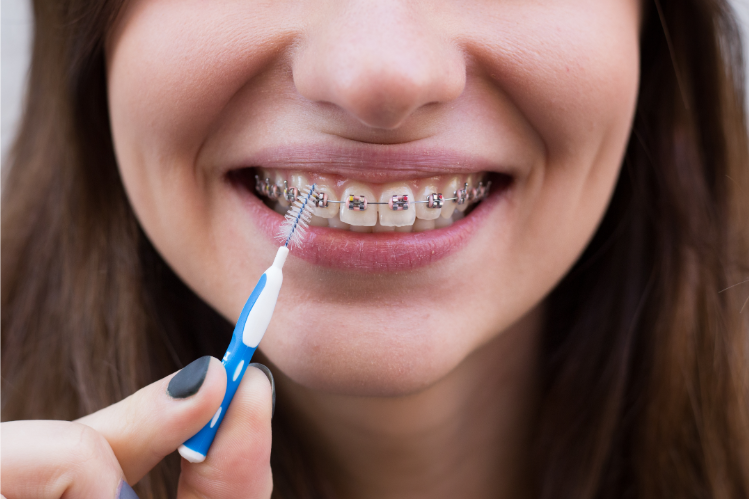
Table of Contents
- Why Flossing with Braces Matters
- The Challenge: Wires in the Way
- How to Clean Your Braces without Breaking Wires
- Tools That Make Flossing Easier
- Natural Teeth Whitening Remedies: Can They Work with Braces?
- DIY Teeth Whitening at Home: What You Should Know
- Canadian Diet and Braces: A Hidden Connection
- Flossing Hacks from Orthodontic Experts
- ALIGNERCO and the Future of Straighter, Cleaner Smiles in Canada
- Tips on Proper Flossing with Braces
- FAQs
Braces do wonderful things for your smile. They straighten, align, and fix bite issues that may have bugged you for years. But anyone who has worn them knows: they complicate even the simplest routines like flossing. Suddenly, what used to take two minutes now feels like threading a needle inside your mouth. And the fear of breaking a wire? Very real.
So, how do you keep your braces clean without frustration or damage? That’s what we’re diving into today. We’ll cover step-by-step techniques on how to floss with braces, share some tips from orthodontic experts, highlight tools that make life easier, and even tie in how ALIGNERCO is making straighter, cleaner smiles more accessible across Canada.
And since many people with braces also worry about staining, we’ll talk about natural teeth whitening remedies, safe DIY teeth whitening options, and ways to whiten teeth while protecting your braces.
Why Flossing with Braces Matters
Think of your braces as little food traps. Every bracket, every wire, perfect spots for plaque to hide. If you skip flossing, it’s like leaving dinner crumbs between your teeth for bacteria to feast on. The result? Stains, cavities, or worse, gum disease.
But flossing with braces isn't just about avoiding bad breath or yellow spots; it is about protecting your investment. Why go through months or years of straightening your teeth, only to have cavities in between them when the process is complete?
A study from the Canadian Dental Association pointed out that people with braces are more prone to gingivitis during treatment if they don’t floss properly. That’s a polite way of saying: ignore flossing now, and you may face bleeding gums and sensitivity later.
The Challenge: Wires in the Way
Normally, flossing is simple: slide the floss between your teeth, clean, done. Braces, however, add a layer of complexity. Those wires block the path, forcing you to thread floss underneath before you can even start cleaning. This is where most people give up. They brush, assume that’s enough, and move on. But brushing with braces, no matter how thorough, doesn’t reach those tight spaces between teeth.
So, yes, the struggle is real, but it’s not impossible.
How to Clean Your Braces without Breaking Wires

Here’s the technique orthodontists recommend:
Use Waxed Dental Floss
Unwaxed floss can shred on brackets. That’s annoying and ineffective. Waxed floss glides better, reducing the risk of fraying.
Thread the Floss Under the Wire
This is the part that tests your patience. Take about 18 inches of floss. Using your fingers, carefully guide one end underneath the wire. If your dexterity isn’t great, floss threaders (cheap plastic tools) can save your sanity.
Slide between Teeth
Once the floss is under the wire, gently work it between two teeth. Hug the floss around one tooth in a "C" shape and move it up and down. Then switch to the other tooth. Don’t yank or press hard; you’re cleaning gums, not scrubbing grout.
Remove and Repeat
Carefully pull the floss out and move to the next gap. Yes, it takes time. But after a week or so, your speed doubles.
Pro Tip: Don’t force it. If you tug too hard, you might bend a wire or pop a bracket loose. Gentle pressure does the trick.
Tools That Make Flossing Easier

Let’s be honest: traditional flossing with braces isn’t fun. Luckily, there are alternatives:
- Floss Threaders – Think of these as sewing needles for your floss. Slide the floss through the loop, and the threader carries it under the wire.
- Orthodontic Floss – Pre-cut strands with a stiff end for threading. Quicker, less fiddly.
- Water Flossers – Devices that shoot a jet of water between teeth and under wires. Some people swear by them. Imagine a tiny power washer for your mouth.
- Interdental Brushes – Small, cone-shaped brushes that slip between brackets and wires. Great for quick clean-ups after meals.
Every orthodontist will tell you: the best method is the one you’ll actually stick to. If a water flosser makes you floss daily, it’s worth every dollar.
Learn the correct way to use dental floss for braces without damaging wires. Follow this simple step-by-step guide using waxed dental floss to keep your teeth and braces clean.
Read more about braces care here.
Natural Teeth Whitening Remedies: Can They Work with Braces?
Many people with braces also ask, "How can I whiten my teeth while wearing these?" The truth: Whitening during treatment is tricky. Brackets cover part of the tooth, which means whitening can leave uneven shades. That said, maintaining brightness naturally is possible.
Here are some natural ways to whiten your teeth (without causing any potential damage to your braces):
- Oil Pulling: Swishing coconut oil in your mouth for 10-15 minutes. It may sound strange, but some people report that it can help to remove surface stains.
- Baking Soda (in moderation): Gently brushing with a combination of baking soda and water is a form of polishing your teeth.
- Crunchy Fruits & Vegetables: Apples, celery, and carrots can work like a natural scrub.
- Avoid Foods That Stain: Avoid coffee, tea, and cola.
As you think about how to whiten teeth with braces, you may want to consider waiting until you are done with your treatment. ALIGNERCO provides guidance for patients on whitening options after treatment, which includes safe at-home kits that are specifically designed for sensitive teeth.
DIY Teeth Whitening at Home: What You Should Know
There’s no shortage of Pinterest hacks claiming to make your teeth instantly whiter. Lemon juice, activated charcoal, hydrogen peroxide… The internet is full of them. But here’s the catch: not all are safe.
- Lemon Juice: Highly acidic. Too much can erode enamel.
- Charcoal: Abrasive. It might make teeth look brighter short term, but it can wear enamel over time.
- Peroxide: Effective in moderation, but overuse can cause sensitivity.
The smartest approach? Talk to a dental professional before trying anything new. And remember, whitening with braces is best done after your brackets come off.
ALIGNERCO recommends natural, gentle methods for maintenance during treatment, then professional-strength options once your teeth are free.
Canadian Diet and Braces: A Hidden Connection
Here’s something people don’t often think about: diet. In Canada, we love coffee, maple syrup treats, and yes, the occasional poutine. But these foods can stain teeth and cling to braces. Coffee, especially, is a notorious stainer. Combine that with braces, and you might notice your teeth looking duller.
Some practical tips:
- Rinse your mouth with water after coffee or tea.
- Stick to lighter-colored foods when possible.
- Balance indulgence with crunchy fruits and veggies.
- Limit sticky foods like caramel or toffee. They’re braces’ worst enemy.
These small steps may not seem like much, but over months of orthodontic treatment, they make a big difference in how your teeth look and feel.
Read more about soft foods for braces and stay on track with your treatment.
Flossing Hacks from Orthodontic Experts
Orthodontists across Canada often share clever little tricks:
- Floss before bed, not in the morning. Food from the day is cleaned out, giving your gums time to recover overnight.
- Keep disposable flossers in your bag. They won’t replace proper flossing, but are useful after lunch on the go.
- Invest in fluoride toothpaste, which strengthens enamel while you focus on gum health with flossing.
These tips may sound minor, but when combined, they make orthodontic care far less overwhelming.
ALIGNERCO and the Future of Straighter, Cleaner Smiles in Canada

Here’s where ALIGNERCO comes in. While flossing with braces is possible, some Canadians are turning to clear aligners instead. Why? Because aligners are removable, which makes cleaning your teeth a breeze. No threading floss under wires. No worries about breaking brackets. Just pop them out, floss and brush like normal, and pop them back in.
ALIGNERCO offers one of the most affordable clear aligner treatments in Canada, designed for convenience without compromising results. And if you’re already wearing braces, ALIGNERCO guides post-treatment retainers and whitening options.
For many, switching to aligners feels like upgrading from a flip phone to a smartphone—it just makes life easier. Plus, ALIGNERCO’s aligners are shipped right to your door, making orthodontics accessible for Canadians living in smaller towns without easy access to orthodontists.
Tips on Proper Flossing with Braces
Flossing with braces may not be fun, but it’s non-negotiable if you care about your teeth and gums. The right tools, whether floss threaders, water flossers, or interdental brushes, make the process manageable. And if you’re looking ahead, clear aligners like those from ALIGNERCO can simplify the journey entirely.
Whiter, straighter teeth aren’t just about looks. They’re about health, confidence, and the habits you build along the way. Whether you stick with braces or explore aligners, remember this: every bit of effort you put into cleaning now will show in your smile for years to come.
FAQs
1. Is it possible to floss with braces?
Yes, with the right tools like floss threaders, orthodontic floss, or water flossers.
2. Is it bad to skip one day of flossing with braces?
Occasionally skipping isn’t harmful, but regular flossing prevents plaque and gum issues.
3. How to floss with braces without a threader?
Use orthodontic floss with a stiff end, interdental brushes, or a water flosser.
4. Do you brush or floss first with braces?
Floss first, then brush to remove loosened debris effectively.
Citations:
Holland, K. (2019, January 23). How to Floss with Braces. Healthline. https://www.healthline.com/health/how-to-floss-with-braces
Best WaterpikTM water flossers for dental braces. (n.d.). https://www.waterpik.com/edu/braces-orthodontics/how-to-floss-with-braces/






